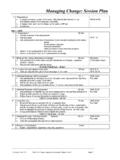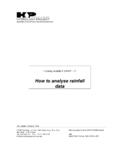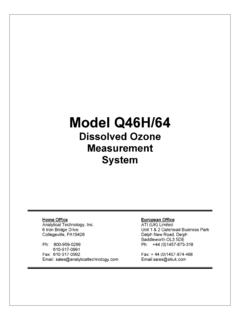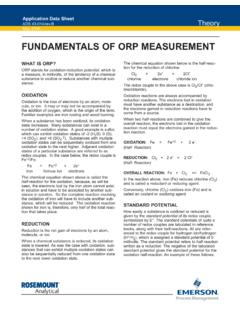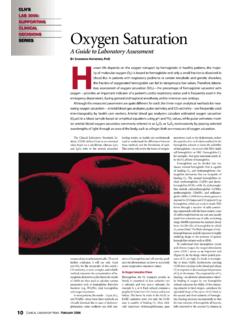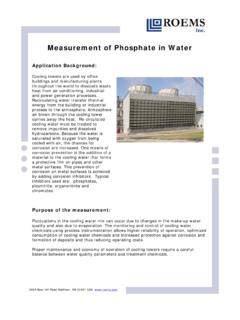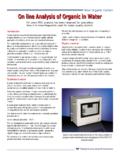Transcription of How to measure chemical oxygen demand - CWC
1 World Bank & Government of The Netherlands funded Training module # WQ - 19. How to measure chemical oxygen demand New Delhi, June 1999. CSMRS Building, 4th Floor, Olof Palme Marg, Hauz Khas, DHV Consultants BV & DELFT HYDRAULICS. New Delhi 11 00 16 India Tel: 68 61 681 / 84 Fax: (+ 91 11) 68 61 685 with E-Mail: HALCROW, TAHAL, CES, ORG & JPS. Table of contents Page 1 Module context 2. 2 Module profile 3. 3 Session plan 4. 4 Overhead/flipchart master 5. 5 Evaluation sheets 10. 6 Handout 12. 7 Additional handout 15. 8 Main text 17. Hydrology Project Training Module File: 19 How to measure Version 05/11/02 Page 1. 1. Module context This module concerns laboratory determination of COD of water samples. Modules in which prior training is needed to complete this module successfully and other related modules are listed below. While designing a training course, the relationship between this module and the others, would be maintained by keeping them close together in the syllabus and place them in a logical sequence.
2 The actual selection of the topics and the depth of training would, of course, depend on the training needs of the participants, their knowledge level and skills performance upon the start of the course. No. Module title Code Objectives 1 Basic chemistry conceptsa WQ - 02 Convert units from one to another Understand the basic concepts of quantitative chemistry Report analytical results with the correct number of significant digits 2 How to prepare standard WQ - 04 Recognise different types of solutions a glassware Use an analytical balance and maintain it. Prepare standard solutions 3 Understanding the chemistry WQ - 11 Appreciate significance of DO. of dissolved oxygen measurement measurement Understand the chemistry of DO. measurement by Winkler method 4 Understanding biochemical WQ - 15 Understand the significance and oxygen demand test theory of BOD test 5 Understanding chemical WQ - 18 Appreciate significance of COD.
3 oxygen demand testa measurement Understand the chemistry of COD. measurement a prerequisite Hydrology Project Training Module File: 19 How to measure Version 05/11/02 Page 2. 2. Module profile Title : How to measure chemical oxygen demand Target group : HIS function(s): Q2, Q3, Q5. Duration : Two sessions, one of 180 min followed by another of 60 min Objectives : After the training the participants will be able to: measure COD of water and wastewater samples Key concepts : Open reflux method Procedure evaluation Training methods : Lecture, laboratory exercises Training tools : Board, flipchart, OHS. required Support of a chemistry laboratory Handouts : As provided in this module Further reading : Standard Methods: for the Examination of Water and and references Wastewater, APHA, AWWA, WEF/1995. APHA Publication Chemistry for Environmental Engineering, Sawyer, McCarty and Parkin. McGraw-Hill, 1994. Hydrology Project Training Module File: 19 How to measure Version 05/11/02 Page 3.
4 3. Session plan No Activities Time Tools 1 Preparations Prepare reagents as listed in the SAP for COD. measurement. Arrange glassware for refluxing Collect/prepare samples as below: sample A, raw sewage sample B, river or pond water sample C, groundwater sample D, potassium hydrogen phthalate, 425 mg/L. 2 Introduction 15 min OHS. Recapitulate significance of COD test Chemistry of the test 3 Source of samples and expected COD values 15 min OHS. Describe the sources of samples and ask the participants to estimate the COD value of each sample Explain significance of the sample aliquot volume to be used 4 Exercise Session I 30 min Ask participants to read the exercise handout and SAP for COD measurement 30 min Assist in making selection of sample volumes and preparation of reaction mixtures Start refluxing of the mixtures. Explain that the refluxing 90 min would be done for one hour instead of two hours as done in standard test to save time While the samples are refluxing, demonstrate the FAS.
5 Titration Session II- 30 min Ask participants to complete the test and report result 5 Wrap up 30 min Ask participants to write report Discuss results Hydrology Project Training Module File: 19 How to measure Version 05/11/02 Page 4. 4. Overhead/flipchart master OHS format guidelines Type of text Style Setting Headings: OHS-Title Arial 30-36, with bottom border line (not: underline). Text: OHS-lev1 Arial 24-26, maximum two levels OHS-lev2. Case: Sentence case. Avoid full text in UPPERCASE. Italics: Use occasionally and in a consistent way Listings: OHS-lev1 Big bullets. OHS-lev1-Numbered Numbers for definite series of steps. Avoid roman numbers and letters. Colours: None, as these get lost in photocopying and some colours do not reproduce at all. Formulas/Equat OHS-Equation Use of a table will ease horizontal alignment ions over more lines (columns). Use equation editor for advanced formatting only Hydrology Project Training Module File: 19 How to measure Version 05/11/02 Page 5.
6 Recapitulate COD. 1. oxygen demand of aggregate organic matter 2. Steps sample + excess oxidant determine remaining oxidant oxidant consumed = COD of sample 3. Complete oxidation Hydrology Project Training Module File: 19 How to measure Version 05/11/02 Page 6. Evaluation of technique Theoretical oxygen demand 425 mg/L KHP has a COD = 500 mg/L. Hydrology Project Training Module File: 19 How to measure Version 05/11/02 Page 7. Sample volume Oxidant quantity should be in excess of sample COD. Example N, 10mL pot dichromate oxygen equivalence = meq or 20 mg O2. for 20 mL sample, COD< 20mg/20mL. or <1000 mg/L. Hydrology Project Training Module File: 19 How to measure Version 05/11/02 Page 8. Samples for analysis Sample Source Predicted Reason COD. A Sewage B River C Well D Standard Hydrology Project Training Module File: 19 How to measure Version 05/11/02 Page 9. 5. Evaluation sheets Hydrology Project Training Module File: 19 How to measure Version 05/11/02 Page 10.
7 Hydrology Project Training Module File: 19 How to measure Version 05/11/02 Page 11. 6. Handout Hydrology Project Training Module File: 19 How to measure Version 05/11/02 Page 12. Recapitulate COD. 1. oxygen demand of aggregate organic matter 2. Steps sample + excess oxidant determine remaining oxidant oxidant consumed = COD of sample 3. Complete oxidation Evaluation of technique Theoretical oxygen demand 425 mg/L KHP has a COD = 500 mg/L. Sample volume Oxidant quantity should be in excess of sample COD. Example N, 10mL pot dichromate oxygen equivalence = meq or 20 mg O2. for 20 mL sample, COD< 20mg/20mL. or <1000 mg/L. Samples for analysis Sample Source Predicted Reason COD. A Sewage B River C Well D Standard Hydrology Project Training Module File: 19 How to measure Version 05/11/02 Page 13. Add copy of Main text in chapter 8, for all participants. Hydrology Project Training Module File: 19 How to measure Version 05/11/02 Page 14.
8 7. Additional handout These handouts are distributed during delivery and contain test questions, answers to questions, special worksheets, optional information, and other matters you would not like to be seen in the regular handouts. It is a good practice to pre-punch these additional handouts, so the participants can easily insert them in the main handout folder. Hydrology Project Training Module File: 19 How to measure Version 05/11/02 Page 15. Hydrology Project Training Module File: 19 How to measure Version 05/11/02 Page 16. 8. Main text Contents 1. Aim 1. 2. Observations & calculations 1. 3. Report 1. SAP for COD measurement 2. Hydrology Project Training Module File: 19 How to measure Version 05/11/02 Page 17. How to measure chemical oxygen demand 1. Aim a. To determine the chemical oxygen demand of various samples of water. b. To evaluate the COD measurement technique using a standard sample. 2. Method a. Read the SAP for COD measurement.
9 B. Prepare the COD reflux mixtures for the four samples in accordance with the procedure. c. Standardise the ferrous ammonium sulphate (FAS) solution. d. You will be told the source of the four samples which you have begun to analyse. Based on this information and your knowledge of water quality and the COD test, fill in a table similar to the one below to predict the COD results which you expect and the reason for your prediction: Sample Source Predicted COD Reason for your COD prediction A. B. C. D. e. Following the reflux, cooling and dilution of the digested mixture, titrate the resulting solution with standardised FAS. 3. Observations & calculations Calculate the COD of each sample in accordance with the Standard Analytical Procedure for the COD test. 4. Report When writing your report the following aspects should be addressed: the aim of the investigation the results that you have produced your original predictions whether the results were as you originally predicted and, if they were not, the reasons why they deviated whether your COD measurement technique was satisfactory the environmental condition of the samples in terms of their pollution potential Hydrology Project Training Module File: 19 How to measure Version 05/11/02 Page 1.
10 Hydrology Project Training Module File: 19 How to measure Version 05/11/02 Page 2. Hydrology Project Training Module File: 19 How to measure Version 05/11/02 Page 3.

